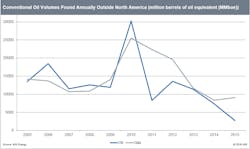IHS: Conventional discoveries outside N. America drop to lowest level since 1952
Just 12 billion boe of estimated recoverable resources were discovered from conventional wells outside of North America in 2015, representing the lowest level since 1952, according to IHS analysis.
The volume of conventional oil alone discovered in 2015 totaled just 2.8 billion bbl, also a record low since the ramp-up of oil and gas exploration began following World War II. More than 9 billion boe of conventional natural gas was discovered globally during the year, marking the fifth straight year in which gas volumes discovered exceeded oil volumes discovered.
“The fall in discovered volumes for conventional oil outside North America, in particular, has been steady and dramatic during the last few years,” commented Leta Smith, director, IHS Energy, upstream industry future service and lead author of the IHS Energy Conventional Exploration and Discovery Trends analysis.
“We’ve seen 4 consecutive years of declining oil volumes, which has never happened before,” Smith explained. “The bottom has completely fallen out for conventional exploration, and the result portends a supply gap in the future that is going to be challenging to overcome. In the current cost-cutting environment, the outlook for 2016 discovery volumes is not likely to be better, either.”
IHS notes exploration and appraisal (E&A) drilling for conventional resources fell sharply in 2015, exacerbating the annual drop in resources found. Last year, slightly fewer than 4,300 conventional E&A wells were drilled outside North America as exploration budgets were cut.
That figure compares with the slightly more than 5,200 conventional E&A wells drilled globally in 2014 and 5,300 in 2012, the latter of which was the peak year for E&A wells drilled during 2005-15.
The number of deepwater E&A wells drilled worldwide dropped more than 20%, while ultradeepwater E&A drilling declined more than 40%, compared with 2014. Deepwater activity in 2015 also showed a marked shift toward appraisal drilling as a portion of total exploration compared with prior years, and IHS researchers expect this trend to continue into 2016.
Shale alone won’t fill gap
“The major implication of this conventional discoveries drop is that declining discovery volumes, combined with anticipated low exploration and appraisal drilling activity for the near future, will create a ‘hole’ in oil and gas operators’ portfolios and eventually negatively impact production,” Smith said. “This would be beyond the impact of current low oil-prices—more likely in the 5- to 10-year range, which is typical between discovery and first production.”
IHS researchers also believe that tight oil in North America is not enough to solve the discoveries shortfall. “Despite its contributions to North American and global supplies, and extraordinary impact on portfolios and investment strategies for many companies, renewed growth in tight oil alone cannot cover the difference in the coming supply gap,” said Jerry Kepes, vice-president of IHS Energy and a co-author of the IHS discoveries analysis.
“IHS is forecasting global tight oil production in 2040 to still be in the range of 10% to 15% of total global oil production, so the world market will still need significant conventional exploration discovery and production.”
The lack of new discoveries, Kepes said, will also increase pressure on operators to develop discoveries already made, grow reserves in their producing fields with improved recovery techniques, change portfolios and investment strategies, or use mergers and acquisitions to restock portfolios in the medium term.
“Conversely, the overall dearth of exploration activity represents an opportunity for some companies, since explorationists have determined that exploration activity will be much less expensive through this period,” Kepes continued.
“Some E&P companies are poised to take advantage of this cost-savings and may see attractive exploration results, even if the overall trend for industry remains more challenging,” he added.
